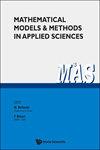Global boundedness in a 2D chemotaxis-Navier–Stokes system with flux limitation and nonlinear production
IF 3
1区 数学
Q1 MATHEMATICS, APPLIED
Mathematical Models & Methods in Applied Sciences
Pub Date : 2023-07-06
DOI:10.1142/s0218202523400067
引用次数: 1
Abstract
We consider the chemotaxis-Navier–Stokes system with gradient-dependent flux limitation and nonlinear production: [Formula: see text], [Formula: see text], [Formula: see text] and [Formula: see text] in a bounded domain [Formula: see text], where the flux limitation function [Formula: see text] and the signal production function [Formula: see text] generalize the prototypes [Formula: see text] and [Formula: see text] with [Formula: see text], [Formula: see text] and [Formula: see text]. For the linear production case of [Formula: see text], the global boundedness of solutions has been verified in the related literature for [Formula: see text]. In this paper, we expand to prove that the corresponding initial-boundary value problem possesses a unique globally bounded solution if [Formula: see text] for [Formula: see text], or if [Formula: see text] for [Formula: see text], which shows that when [Formula: see text], that is, the self-enhancement ability of chemoattractant is weak, the solutions still remain globally bounded even though the flux limitation is relaxed to permit proper [Formula: see text]; however, if [Formula: see text], it is necessary to impose the stronger flux limitation than that in the case [Formula: see text] to inhibit the possible finite-time blow-up. This seems to be the first result on the global solvability in the chemotaxis-Navier–Stokes model with nonlinear production.具有流量限制和非线性产生的二维趋化- navier - stokes系统的全局有界性
我们考虑具有梯度相关通量限制和非线性产生的趋化性Navier-Stokes系统:[公式:见正文]、[公式:参见正文]、]公式:见文本]和[公式:看文本]在有界域中[公式:见图文本],其中通量限制函数[公式:见文本]和信号产生函数[公式,见文本]用[公式,看文本]、[公式,见图文本]和[公式。对于[公式:见正文]的线性生成情况,[公式:参见正文]的相关文献已经验证了解的全局有界性。在本文中,我们扩展证明了相应的初边值问题具有唯一的全局有界解,如果[公式:见文本]为[公式:看文本],或者如果[公式,见文本],这表明当[公式,看文本]时,即化学引诱剂的自增强能力较弱,即使通量限制被放宽以允许适当的[公式:见正文],解仍然保持全局有界;然而,如果[公式:见正文],则有必要施加比[公式:参见正文]情况下更强的通量限制,以抑制可能的有限时间爆炸。这似乎是关于具有非线性产生的趋化性Navier-Stokes模型的全局可解性的第一个结果。
本文章由计算机程序翻译,如有差异,请以英文原文为准。
求助全文
约1分钟内获得全文
求助全文
来源期刊
CiteScore
6.30
自引率
17.10%
发文量
61
审稿时长
1 months
期刊介绍:
The purpose of this journal is to provide a medium of exchange for scientists engaged in applied sciences (physics, mathematical physics, natural, and technological sciences) where there exists a non-trivial interplay between mathematics, mathematical modelling of real systems and mathematical and computer methods oriented towards the qualitative and quantitative analysis of real physical systems.
The principal areas of interest of this journal are the following:
1.Mathematical modelling of systems in applied sciences;
2.Mathematical methods for the qualitative and quantitative analysis of models of mathematical physics and technological sciences;
3.Numerical and computer treatment of mathematical models or real systems.
Special attention will be paid to the analysis of nonlinearities and stochastic aspects.
Within the above limitation, scientists in all fields which employ mathematics are encouraged to submit research and review papers to the journal. Both theoretical and applied papers will be considered for publication. High quality, novelty of the content and potential for the applications to modern problems in applied sciences and technology will be the guidelines for the selection of papers to be published in the journal. This journal publishes only articles with original and innovative contents.
Book reviews, announcements and tutorial articles will be featured occasionally.

 求助内容:
求助内容: 应助结果提醒方式:
应助结果提醒方式:


